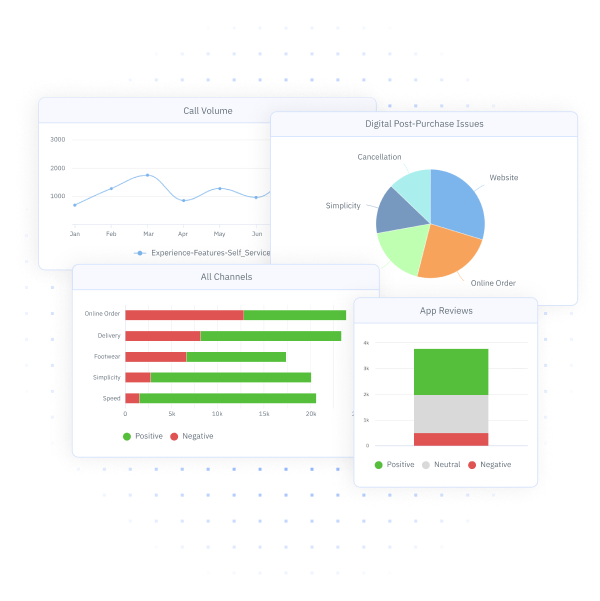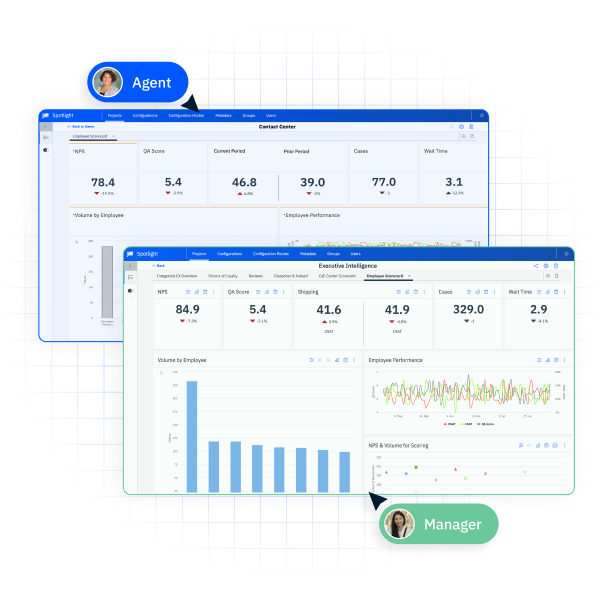Conversational Analytics: Powerful Data Behind Business Transformation
Conversational analytics is a powerful tool that can help organizations improve customer experiences, optimize sales and operations, and drive better business outcomes.
When you analyze the natural language interactions between customers and an organization, conversational analytics unlocks a wealth of insights that can be used to resolve issues faster, enhance agent performance, reduce costs, and demonstrate the value of customer service investments. Discover the power of conversational analytics, its benefits, and the key features to look for in a conversational analytics solution.
What is Conversational Analytics?
Conversational analytics, also called conversational intelligence or conversational AI, is the process of analyzing natural language conversations between an organization’s customer service or contact center agents (both human and virtual) with that organization’s customers or clients. The goal of employing conversational analytics software is to improve the customer experience, leading to greater retention and less churn.
Conversational analytics software can be applied across a variety of channels where these interactions take place, such as social media, contact centers, online forums, email, messaging apps, or virtual assistants and chatbots.

Why is Conversational Analytics Important?
Conversational analytics is important because conversations are the central point of customer experience improvement. A wealth of insights lies in the interactions between your organization and its customers; however, without specialized technology to analyze that data, those insights remain untapped.
With conversational analytics, organizations can improve customer experiences by seamlessly combining contact center conversations, emails, chats, and calls, with other customer feedback channels like surveys, reviews, and social media, thereby gaining a holistic view of the customer journey.
What are the Benefits of Conversational Analytics?
Conversational analytics unlocks valuable insights from customer interactions, enabling businesses to enhance customer experiences, improve decision-making, and boost operational efficiency. By analyzing conversations across multiple channels, companies can better understand customer needs, identify trends, and drive meaningful improvements that lead to greater satisfaction and loyalty.
Resolve Customer Issues Faster
Conversation analytics enables businesses to identify recurring issues, detect customer sentiment, uncover root causes, assess agent performance, personalize resolutions, automate workflows, and streamline customer support processes. By leveraging these insights, companies can proactively address common problems, prioritize urgent issues, and optimize their operations to resolve customer concerns more efficiently.
Improve Agent Performance and Retention
Conversation analytics provides businesses with invaluable insights into customer interactions, allowing them to identify areas where agents can improve their performance. By analyzing call recordings and agent-customer transcripts, businesses can pinpoint common mistakes, identify training opportunities, and provide targeted coaching. This not only leads to better customer experiences but also boosts agent morale and job satisfaction, ultimately improving retention rates.

Reduce Cost to Serve and Handle Time
Conversation analytics can significantly reduce the cost of serving and handling time by identifying inefficiencies in agent interactions. By analyzing conversational data, businesses can pinpoint repetitive tasks, streamline processes, and provide agents with the tools and training they need to resolve issues more efficiently. This ultimately leads to reduced call durations, increased agent productivity, and lower operational costs.
Earn a Higher Share of Wallet
Conversation analytics can help businesses earn a higher share of wallet by providing insights into customer satisfaction and loyalty. By analyzing customer interactions, businesses can identify opportunities to upsell, cross-sell, and provide personalized recommendations. This helps to deepen customer relationships, increase customer lifetime value, and ultimately drive higher revenue.
Demonstrate Return on Customer Service Investment
Conversation analytics provides businesses with tangible evidence of the customer experience ROI from their efforts. By analyzing customer interactions, businesses can measure key performance indicators (KPIs) such as customer satisfaction, first contact resolution rates, and average handle time. This data can be used to demonstrate the impact of customer service initiatives on revenue, cost savings, and customer loyalty, providing a strong justification for continued investment in customer service.
Conversational Analytics Examples and Use Cases
Conversational analytics is revolutionizing the way businesses understand and engage with customers. By analyzing interactions across various channels, companies can uncover valuable insights, optimize customer experiences, and make data-driven decisions. Whether it’s improving customer support, enhancing sales strategies, or driving product innovation, conversational analytics offers a wide range of applications and use cases that can significantly impact business outcomes. Discover a few examples and use cases of conversational analytics:
Customer Experience Optimization
Analyzing customer service calls to identify common issues, pain points, and opportunities for improvement can provide valuable insights for improving the customer experience. This can involve monitoring conversations to measure customer intent, satisfaction, sentiment, and the effectiveness of customer service agents. Additionally, automating responses and providing agents with real-time suggestions or next-best actions can help improve the overall customer experience.
Compliance and Risk Management
By monitoring conversations, conversation analytics can detect potential compliance issues, such as the use of inappropriate language or the disclosure of sensitive information. Analyzing interactions can also help identify and mitigate various risks, including potential security breaches or regulatory violations. Conversations can also be automatically flagged for further review or escalation, allowing organizations to proactively address compliance and risk-related concerns.
Sales Process Improvement
Organizations can gain valuable insights into the most effective sales techniques, objection-handling strategies, and customer pain points. This data can then be used to provide sales and customer service teams with recommendations to optimize their sales processes and improve conversion rates. Additionally, conversation analytics can help identify top-performing sales representatives, allowing organizations to train others to adopt the successful tactics of their most effective salespeople.
Product Development and Feedback
Organizations can gather valuable feedback on existing products and services, providing insights that can inform product roadmaps and future development. This process can help identify emerging trends, consumer preferences, and unmet needs that can guide the product development process. Additionally, monitoring social media and online forums can provide real-time feedback and sentiment analysis on products and services, enabling organizations to quickly respond to customer concerns and preferences.
Employee Training and Coaching
Organizations can identify areas for improvement in collaboration, leadership, and professional development. This data can then be used to provide personalized feedback and coaching to employees based on their communication patterns and skill gaps. The automation of coaching opportunities and the sharing of best practices across the organization can help optimize employee development and performance.
Market Research and Competitive Analysis
Organizations can gain a deeper understanding of market trends, competitor positioning, and overall industry dynamics. This data can help identify emerging topics, keywords, and language patterns that provide valuable insights into consumer behavior and preferences. Benchmarking the performance of a company’s customer interactions against industry standards or competitors can help identify areas for improvement and opportunities to differentiate the business in the market.
How Does Conversational Analytics Work?
Conversational analytics platforms first collect conversational data from various sources like call recordings, chat logs, emails, and social media interactions. This data is then ingested into the system, where it’s preprocessed to remove noise (e.g., filler words, irrelevant data). For voice-based conversations, the software transcribes spoken words into text using speech-to-text technology, and this transcription serves as the basis for further text analysis.
The software then applies natural language processing (NLP) techniques to understand the content of the conversations. This includes tokenization (breaking down text into smaller parts like words and phrases), sentiment analysis and emotion detection (determining the sentiment behind the words), intent recognition (identifying the purpose or intent behind the conversation), and entity recognition (detecting specific information like names, dates, and product names). The software also attempts to understand the context of the conversation, including the relationship between different parts of the conversation and the overall tone. More modern systems also incorporate GenAI models to create summaries of customer interactions.
Machine learning models are used to identify patterns in conversations, such as frequently asked questions, common complaints, or recurring issues. The software can also detect outliers or unusual behavior in conversations that might indicate problems or opportunities, and it can identify trends over time, such as emerging topics of concern or changes in customer sentiment. The insights derived from the analysis are presented in dashboards, reports, or visualizations, which can include sentiment trends, most common topics or keywords, customer satisfaction metrics, and agent performance metrics.
The software should also integrate with other tools (like CRM systems) and other VoC data to provide actionable insights directly where they’re needed, and alerts or automated actions can be triggered based on specific conditions, such as a drop in customer satisfaction or a surge in negative sentiment. Finally, the software uses feedback and new data to continuously refine its models and improve accuracy over time, with machine learning models being retrained periodically to adapt to new language patterns, customer behaviors, and business needs.
What are the Challenges that come with Conversation Analytics?
Conversation analytics, while a powerful tool, faces several significant challenges. That’s why it’s crucial to recognize these challenges and take steps to address them.
Nuances of natural language and multilingual support
One of the primary difficulties lies in the nuances of natural language. Understanding the context is crucial, as natural language is rich in subtleties that algorithms often struggle to fully grasp. Ambiguity and polysemy—where many words have multiple meanings—add to the complexity, making it challenging to determine the intended interpretation. Additionally, informal languages, such as idioms and slang, can be particularly difficult for machines to understand accurately. Likewise, complexity multiplies when incorporating more languages into the analysis to maintain the software’s accuracy, as many global brands require this capability.
Data quality
Another major challenge is related to data quality and noise. Transcription errors in speech-to-text processes can lead to inaccurate analysis, while background noise and interference can hinder accurate speech recognition. Furthermore, conversations may be incomplete or cut off, complicating efforts to derive meaningful insights.
Privacy, ethics, and biases
Privacy and ethical considerations also play a critical role in conversation analytics. Handling sensitive information requires robust data security measures, and there’s the added risk that algorithms may perpetuate biases present in their training data, potentially leading to unfair or discriminatory outcomes.
Scalability
Scalability and efficiency present another set of challenges. Analyzing large volumes of conversational data demands significant computational resources, and real-time processing, especially for complex analyses, can be computationally intensive.
Interoperability
Integration with other systems is also complex. Interoperability challenges arise when attempting to integrate conversation analytics with other systems, such as CRM or marketing automation tools. Ensuring data consistency and compatibility across different systems further complicates the process.
Measurement
Finally, evaluation and measurement are challenging in conversation analytics. Developing appropriate metrics to evaluate effectiveness is difficult, and human judgment is often required to assess the quality of the insights generated by algorithms.
What Features to Consider for Conversational Analytics Software?
Not all conversational analytics software is created equal. That’s why it’s essential to carefully evaluate key features to choose the solution that best aligns with your business needs and empowers you to make data-driven, impactful decisions. Below are key features to consider:
Advanced Transcription Services: Convert extensive audio recordings into text to leverage the capabilities of AI and text analytics.
Agent and Coach Performance Metrics: Evaluate agent and team performance with detailed scorecards highlighting strengths and areas for improvement.
AI-Powered Summarization: Leverage generative AI to reduce average handle time (AHT) by 33% through concise call summaries.
AI-Powered Text Analytics: Analyze unstructured data to uncover feedback patterns, themes, and anomalies.
Conversational Insights: Extract valuable insights from threaded conversations between agents and customers to enhance understanding.
Omnichannel Voice of the Customer (VOC): Integrate interaction data across various channels to create a comprehensive view of customer feedback. This goes beyond just customer sentiment analysis, providing better insights into your customers’ emotions and trends.
Quality Assurance: Identify gaps in knowledge and quality, and discover opportunities to enhance training programs.
Impact Analysis: Identify key factors and opportunities that have the most significant influence on your metrics.

InMoment has been recognized as a leader in The Forrester Wave™: Text Mining and Analytics Platforms for Q2 2024. We earned the highest possible rating in 11 key evaluation criteria, including:
- AI capabilities in knowledge base, symbolic processing, pre-processing, and post-processing
- Document-level text mining and natural language processing (NLP)
- Advanced natural language understanding
We also achieved top rankings for support, innovation, roadmap, and globalization—essential elements that empower you to drive transformative business change.
Partner with InMoment on Conversational Analytics
InMoment’s conversational analytics software utilizes award-winning NLP and AI technology that continuously tops reports by leading analyst firms, so you can be confident you’re receiving state-of-the-art in AI, machine learning, and natural language processing.
InMoment can also go beyond just your conversational data to pull together all of your strongest CX data signals from every system, channel, and perspective for a truly integrated CX program. Unlike other vendors, InMoment uniquely combines software and services for proactive guidance and actionable insight, leading to the highest impact programs with the fastest ROI. Schedule a demo to learn more about our conversation analytics solutions.
